Вирус welcome to nginx
Nginx вирус маскируется под пустой страницей?

Тем не менее, домен не предоставляет никакого полезного контента. Кроме того, пользователи могут попасться на другой веб-странице — Nginx.org. Конечно, вы можете задать вопрос, что такое Nginx.org. На первый взгляд это выглядит как домен, который продвигает разные версии Nginxприложения. Обратите внимание, что вы не должны допускать заражение браузера законным приложением, которое продвигается на nginx.com.
Возможно, что это вредоносная браузер угроза служит убежищем для более сложных угроз. Если вы заразились браузер перенаправляющим вирусом, вы можете заметить следующие последствия:
- перенаправления на игровые или порнографические домены
- реклама, появляющиеся на законных веб-сайтах
- измененная домашняя страница
Хотя вредоносное Nginx угроза не “захватывает” ваш браузер, его неясное поведение, безусловно, вызывает сомнения. Наконец, этот домен не содержит ни документа EULA, ни документа политики конфиденциальности. Информация о разработчиках этой веб-страницы также отсутствует. Подводя итоги, удалите скрипты Nginx вируса и верните любые изменения, внесенные в ваш браузер.
Пустая страница в качестве маскировки?
К сожалению, существуют десятки, если не сотни, таких же доменов, которые ведут себя аналогичным образом, например 1.loadblanks.ru. Они представляют собой совершенно пустую страницу без каких-либо подсказок или каких-либо элементов контента. Количество таких веб-страниц предполагает, что для них существует сдержанная цель. Они могут содержать гораздо сложный набор вирусов — эксплойты.
Кроме того, подобные домены могут служить областями, в которых есть файлы cookie отслеживания или другие элементы. Таким образом, они отслеживают, какие веб-страницы чаще всего посещают пользователи. После передачи собранных данных соответствующим третьим лицам последние могут создавать объявления, соответствующие интересам пользователей и потребностям. Короче говоря, это облегчает онлайн-маркетинг с прибылью за клик.
Также, вы должны быть осторожны с явлением Nginx перенаправления. Учитывая поведение этого домена, вы можете оказаться на потенциально мошеннических доменах. Обратите внимание, что угонщик также привлекает пользователей мобильных устройств. Если вы уже ищете решение о том, как удалить Nginx со своего телефона, используйте приведенные ниже инструкции.

Nginx.org предположительно, продвигает версии законного приложения Nginx. Излишне говорить, что установка одного из них может вызвать ряд проблем с браузером.
Техники распространения?
Вредоносная браузер программа имеет тенденцию распространяться в виде веб-скриптов, а не как полноценная ПНП. Из-за такой неясной формы вы можете столкнуться с этим паразитом в менее защищенных доменах покупок или игровых веб-страницах.
Таким образом, чтобы избежать “Nginx захвата”, вы должны установить утилиту устранения вредоносных программ, например Reimage Reimage Cleaner Intego или Malwarebytes, чтобы избавиться от таких перенаправлений.
Устранение Nginx угрозы с вашего смартфона или браузера ПК
Поскольку это вредоносное ПО не содержит конкретного приложения, нет необходимости удалять Nginx. Тем не менее, это не означает, что вы не должны игнорировать такую переадресацию, даже если вы оказались там однажды. Руководство по удалению Nginx поможет вам удалить все веб-элементы, связанные с угонщиком.
Если вы являетесь мобильным пользователем, вы можете удалить Nginx из Android с помощью Malwarebytes. Это антивирусное приложение обеспечивает достаточную защиту для мобильных пользователей. Этот метод также помогает удалить Nginx вирус пользователям ПК. Французские пользователи должны быть особенно осторожны в отношении этой угрозы.
Вы можете устранить повреждения вируса с помощью Reimage Reimage Cleaner Intego . SpyHunter 5 Combo Cleaner and Malwarebytes рекомендуются для обнаружения потенциально нежелательных программ и вирусов со всеми их файлами и записями реестра, связанными с ними.
“I am trying to reach Google, Yahoo!, Yandex, or some other website. Instead getting to the site, I see a web page that refers to nginx:
What is the “Welcome to nginx!” Page?
The Welcome to nginx! page is the default web page that is presented when a website operator has installed the NGINX web server software on a computer on the Web, but has not finished configuring it.
The NGINX web server software is used by millions of websites worldwide. It’s open source and free to use, so anyone can download and install the software and use it to host a website.
Why Am I Seeing this Page?
When you see the Welcome to nginx! page, the mostly likely reasons are that either there is a configuration problem at the website, or there is a problem on your computer that is causing your web browser to go to the wrong website.
-
It might be a temporary problem, in which case it might help to clear your browser cache and history, then restart your computer and home router if necessary. See What Should I Do?.
It is also possible that your computer has a virus or other malware that is intercepting your web requests and directing you to the wrong website.
The NGINX software has not been installed on your computer – it runs only on computers that are serving web pages. NGINX is not a virus and has nothing to do with determining which websites your browser accesses.
What Should I Do?
We recommend that you do the following. After each step, test whether the problem is fixed:
- Clear your browser cache and delete your browsing history. Restart your web browser.
- Restart your computer and home router.
If you don’t want to investigate the problem yourself, contact a qualified expert – your ISP or support representative – and ask for help scanning your computer for malware and verifying your DNS and network configuration.
If you feel like investigating further, below are some other things for a knowledgeable user to try.
Run a scanner or anti-malware application from a security software company. Users of Windows 8.1 and later can use Windows Defender, which is free antimalware software included with Windows. Windows 7 users can use Microsoft Security Essentials.
- Clear your operating system’s DNS cache.
- On Microsoft Vista, Windows 7, and Windows 8: Click on the Start logo, follow All Programs > Accessories , right-click on Command Prompt , choose Run As Administrator , type ipconfig /flushdns , and press Enter.
- On Microsoft Windows XP, go to Start > Run , type ipconfig /flushdns in the new terminal window, and press Enter.
- Go to your TCP settings (on Windows, Control Panel > Network ), and locate the section that lists the DNS servers. Make a note of the current values, and then replace them with 8.8.8.8 and 8.8.4.4. You will then be using Google Public DNS instead of your previous DNS server. For more details, see Get Started page for Google Public DNS.
- Check the hosts file on your computer. Windows users, see How to reset the Hosts file back to the default at the Microsoft Support website.
- Check the plug-ins and extensions installed with your browser. Re-install your browser or try a different one if possible.

Learn how to protect your apps with NGINX and NGINX Plus






- Из Дефолтситевск
Что такое Welcome to Nginx?
Но я не хозяин сервера, я вообще открыл чужой сайт и увидел эту ошибку! Как убрать Welcome to Nginx?
Если быть точным, то это не ошибка. Это просто страница по умолчанию. Причин такого поведения может быть довольно много. Проблема, скорее всего, на стороне сервера. Единственное, что можете сделать вы как клиент - отчистить кэш DNS и попробовать зайти снова. Возможно, что сайт, который вы запрашиваете, переехал или сменил IP, а вы просто попадаете на старый сервер/IP, где его уже нет, и получаете стандартный ответ.
Я хозяин сервера, что мне делать!?
С тем, что такое Welcome to Nginx мы уже разобрались. Из "ниоткуда" эта страница взяться не может. Если вы только установили nignx, то значит вам просто нужно настроить виртуальные хосты. Если вы настроили их, конфигурация рабочая и стартует, но вы получаете эту страницу, значит настроили что-то неправильно. Гадать - неблагодарное занятие, нужно смотреть конфигурацию. Например банальная опечатка в домене в имени виртуального хоста приведет к показу дефолтной страницы.
А можно сменить страницу Welcome to Nginx на что-то другое ?
Без проблем. Если nginx не находит хост под переданный домен, он отдает первый хост в конфигурации. Так что вы можете разместить как ответ по умолчанию все, что вашей душе угодно.






- Из лесу, вестимо






- Из Дефолтситевск






- Из лесу, вестимо
Насколько я влез в тему, это единственная преграда для лодыря – правила рерайта для каждого домена прописывать прямо в конфиге nginx, нет файла локальных настроек, чтоб, значит, прямо под рукой в корне. И не очень разбежишься ставить истрепанные общеизвестные движки. Но это уже преграда для других лодырей, мне не важно.
Если собраться с духом и затеять небольшой самопальный скайнет, то мне достаточно поддержки php.






If you are experiencing Internet browser showing an error page that says Welcome to Nginx!, this implies an error on your network settings or remote server. The page is not blocking your indented web site neither proves that computer is infected with viruses. There are so many ways why computer users are seeing this error page. One thing we can assure you is that Nginx is a legitimate program used by many legal web sites. Welcome to Nginx! page itself is not a virus; however, we cannot overrule findings of some that it is merely cause by the infection. It can be due to compromised computer or web server. Malware presence may also carry out changes on your browser or system to suffer from this redirect.
Before we can proceed further, there are many things we need to emphasize about Nginx, the company, and the so-called Nginx virus.
What is Nginx?
Nginx is a company that writes and distributes free open source web server software. It fact, it is widely used worldwide and rank as second of the most popular open source web server in the world. The Nginx engine is being applied on almost 10% of web site. However, the company has no control on its usage. It can be utilized for legitimate purposes, as well as illegal ones.
The program was developed in good intention and aims to enhance the performance and scalability over the Internet. Nginx is not in any way connected with harmful activities that cyber criminals are staging online.
Why am I seeing �Welcome to nginx!� Screen
First and foremost, if you see �Welcome to nginx!� while browsing the web, it does not necessarily mean that you are redirected to Nginx company web site. No components of Nginx are present on your computer. We cannot discount the probability that a malware or virus has altered with your network settings that may redirect you to a harmful server running on Nginx platform.
A web page containing �Welcome to nginx!� message is merely a diagnostic response generated by web sites running on Nginx servers. Even some popular and harmless web sites may issue this warning if errors occurred. Here are some screenshot of �Welcome to nginx!� screen.


What can I do to stop �Welcome to nginx!� from appearing?
We highly encourage you to run anti-virus scan on the computer. Checking your PC with different anti-virus and anti-malware program can help find malware that are deeply hidden on the systems. Other than that, you may also execute these steps:
To remove risky items from your computer, download Malwarebytes Anti-Malware by clicking on the button below. This tool is effective in getting rid of Trojans, viruses and malware.
1. After downloading, please install the program using the default settings.
2. At the end of the installation, please make sure that it will download necessary updates.
3. Once update has completed. The tool will launch.
4. Thoroughly scan the computer and remove all threats detected by this anti-malware program.
If the scan comes clean and �Welcome to Nginx!� is still bothering you, we suggest that you must proceed with the added procedures below.

4. Make sure that you place a check mark on boxes Preserve Favorites website data, Temporary Internet files, Cookies, and History.
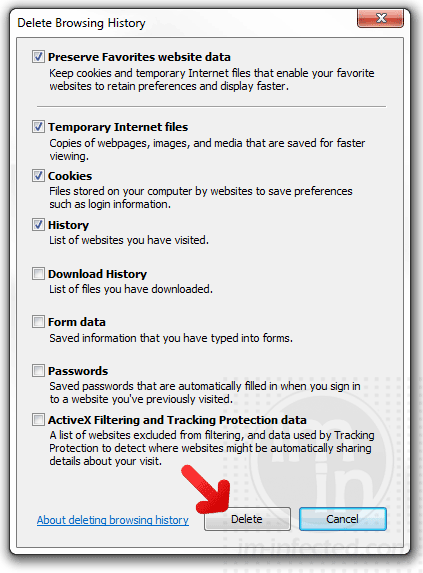
5. Click on Delete button to proceed.
1. Open Google Chrome Internet browser
2. Click on the Customize/Settings icon on upper right corner of the browser.
3. Select Settings from the drop-down list.
4. On Settings page, browse to the Privacy section. You need to click on �Show advance settings� to reveal all contents.
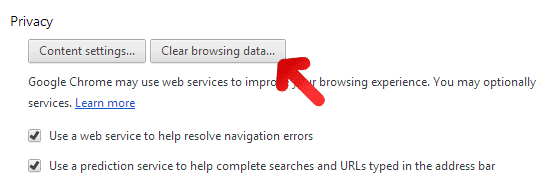
5. Click on �Clear browsing data� button. It will open the main configuration window.
6. In �Obliterate the following items from� field, select appropriate period when �Welcome to Nginx!� starts to appear on the computer.
7. Refer to image below for proper items you must clear.

8. Finally, click on Clear browsing data button to start the process.
3. Select Toolbars and Extensions on left panel. Go to right panel and look for related item.

1. Launch the program Google Chrome.
2. Click on the Wrench icon on top right corner of the browser.
3. Choose Settings from the drop down list. It will open a window containing Google Chrome settings.
4. Click on Extensions of the left side bar to display all installed extensions.
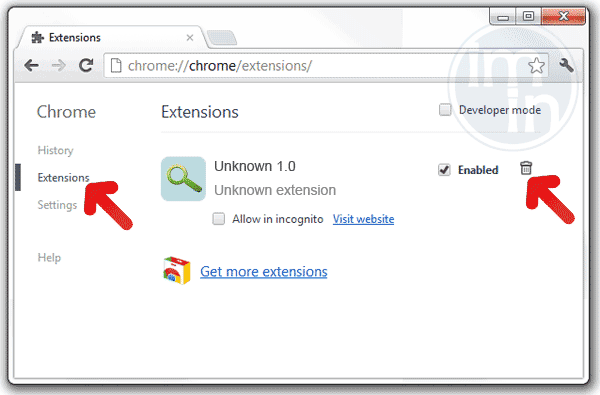
5. On the right panel of the window, Disable/Delete (Trash) extensions.
6. Close the current window and restart Google Chrome.
1. Open Mozilla Firefox Internet browser.
2. On top menu, click on Tools and select Add-ons from the list. You can also press CtrlShift+A on your keyboard to access this option.
3. Once the Add-ons manager is open, select Extensions from the sidebar.
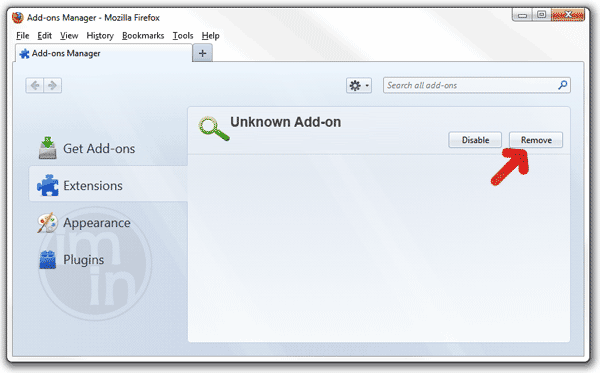
4. Find the unknown add-on and click on Remove button. Click OK to save the settings.
5. Please restart Firefox to complete the process.
If the web site you are trying to visit is blocked or redirected to �Welcome to Nginx!� page, resetting the DNS settings after malware alteration may help.
1. Download MiniToolBox from this page.
2. When download completes, double-click the file to run. This is just a compact tool that opens a small window.
3. On the console of MiniToolBox, be sure to check boxes of Flush DNS, Reset IE Proxy Settings, and Reset FF Proxy Settings.
4. Click the GO button to initiate the process.
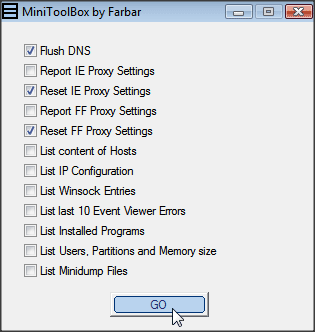
Unwanted entries from the Windows hosts file is also allows your browser to be redirected to harmful web sites or show �Welcome to Nginx!� page if not resolved properly. Solve this by removing extra entries from the hosts file.
1. Browse to C:\WINDOWS\System32\drivers\etc\.
2. Using a NotePad program, please open the file �hosts�.
3. Refer to image below as the original Windows hosts file. If you are seeing added values, please remove them.

4. Save the file once you have finished the making changes.
Читайте также:


